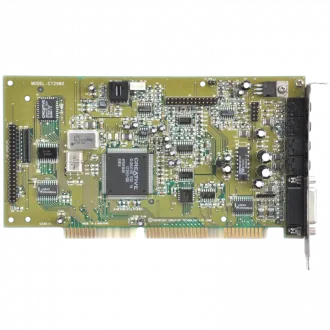Sound Blaster 16 (released June 1992), was the successor to Sound Blaster Pro and introduced 16-bit digital audio sampling to the Sound Blaster line. They also, like the older Sound Blasters, natively supported FM synthesis through a Yamaha OPL-3 chip. The Sound Blaster 16 often referred to a SB16 also featured a connector for add-on daughter-boards with wavetable synthesis (actually, sample-based synthesis) capabilities that complied to the General MIDI standard. Drivers are widely available for early versions of Windows and for retro computing and gaming the Sound Blaster 16 is a still held in high regard.
Drivers for early Operating Systems are easy to install, you may have to make sure there are no conflicts with other hardware but other than that it is straight forward. Installation makes modifications to the config.sys and autoexec.bat files to automate driver loading upon boot into DOS and later Windows GUI. If you are using a simulator such as DOSBOX then drivers may not be necessary at all as emulation of Sound Blaster (Original) and Sound Blaster 16 are implemented.
All Model numbers for this device
The various models:
- Sound Blaster 16 SCSI-2 with a built-in SCSI adapter. ASP socket.
- Sound Blaster 16 MCD "Multi-CD" with all of the old proprietary CD interfaces (no ATAPI). ASP socket.
- Sound Blaster 16 Value Edition No ASP socket or Wave Blaster header. A cost-reduced board.
- Sound Blaster 16 IDE with the then-new ATAPI IDE interface for CD-ROMs. ASP socket.
- Sound Blaster 16 ASP with the ASP chip included. Includes CD-ROM interface(s).
- Sound Blaster 16 WavEffects a cheaper and simpler redesign of the Sound Blaster 16, released in 1997, packaged with Creative's WavEffects wavetable software.
- Sound Blaster 16 PCI it is called a Sound Blaster 16, but it has little in common with the ISA variant. This board is based on the acquired Ensoniq AudioPCI technology.
Model Numbers:
CT1770
CT2230
CT2940
CT2890
CT2840
CT2810
CT2806
CT280
CT2805
CT2804
CT2802
CT2801
CT2800
CT2772
CT2771
CT2CT262
CT2CT261
CT2CT260
CT2963
CT2962
CT2961
CT2951
CT2945
CT2943
CT2942
CT2941
CT2940
CT2906
CT2901
CT2900
CT2891
CT2892
CT4170
